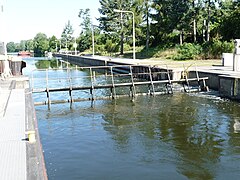Folding gate
A single-leaf lock gate of a ship lock with a horizontal axis of rotation attached to the lock chamber floor is referred to as a folding gate .
Layout and function
The flap gate of a lock consists of a gate that can be rotated around a horizontal axis, similar to a flap, which in the raised position diverts the water pressure of the upper water onto the seal bearing of the lock structure and closes the lock chamber. The lock chamber is opened by placing the folding gate in the lock chamber floor, which is recessed accordingly for this purpose. Watercraft then drive over the hinged gate to leave the lock. Folding gates are used almost exclusively as a locking device on the head of a lock. In order to be able to use the entire length of the chamber, the gate opens to the upper water. The first folding doors were made of wood. While later iron or steel rivet constructions were common, today folding doors are built in a fully welded construction form and moved electrically or hydraulically.
Examples
Wusterwitz lock , folding gate with jamb
Rothensee lock , folding gate, upper water
Plötzensee lock , water level leveled, gate folds forward
Other types of lock gates
- Lifting gate as a protective board with vertical movement in the direction of the gate level upwards.
- Segment gate as a damming body rotatable about a horizontal axis with a circular cylindrical gate skin.
- Sliding gate as a one-piece panel that can be moved horizontally.
- Mortise gate made of two leaves with a vertical axis of rotation.
literature
- Otto Lueger: Lexicon of the entire technology and its auxiliary sciences Volume 7 Stuttgart, Leipzig 1909, P. 721–723.
- H. Dehnert: Locks and Hebewerke Springer-Verlag, Berlin, Heidelberg 1954, ISBN 978-3-540-01807-0



